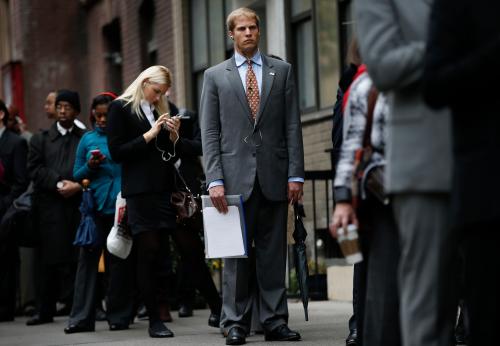This commentary originally appeared on Project Syndicate on June 21, 2017.
The world is experiencing a slow-motion economic crisis – one that, most experts agree, will continue for the foreseeable future. The global economy has grown in fits and starts since the economic crisis of 2008 – one of the longest recorded stagnations of the modern era. In virtually all middle- and high-income countries, wages (as a share of GDP) have been steadily declining for nearly 40 years. But what about the next 50?
Today, the situation certainly looks bleak. Economic stagnation and widening inequality have contributed to a surge in xenophobia and nationalism in the advanced countries, exemplified by the United Kingdom’s vote to exit the European Union and the election of US President Donald Trump – and now his decision to withdraw from the Paris climate agreement. Meanwhile, large parts of the developing world – notably, the Middle East and North Africa – have been embroiled in conflict, with some teetering on the edge of state failure.
But while such turbulence is likely to continue for the near future, there is little consensus on what lies beyond that. To be sure, long-run forecasting is usually a fool’s errand. In 1930, in similarly troubled times, none other than John Maynard Keynes tried his hand at it, with the famous essay “Economic Possibilities for our Grandchildren.” He got his forecast wrong.
Nonetheless, Keynes’s attempt surely sets a respectable precedent for economic future gazing. So here I go: in 50 years, I predict that the world economy is likely (though not guaranteed) to be thriving, with global GDP growing by as much as 20% per year, and income and consumption doubling every four years or so.
At first, this scenario probably seems farfetched. After all, the global economy currently is growing at a rate of just 3% annually (a bit worse, in the last few years). But it wouldn’t be the first time global economic growth accelerated to previously unimaginable levels.
From 1500 to 1820, according to data collected by the late Angus Maddison, the world’s annual growth rate was just 0.32%, with large sections of the world experiencing no growth at all. In China, annual per capita income stood at $600 throughout this period. For someone living at that time, today’s disappointing 3% growth rate would have been inconceivable. How could they anticipate the Industrial Revolution, which lifted average annual global growth to 2.25% from 1820 to 2003?
Today, it is the Digital Revolution that promises to lift growth to new heights. Indeed, we are in the midst of dramatic technological breakthroughs, with advances in digital technology connecting all corners of the world. As a result, workers are not just becoming more productive; they are gaining greater access to employment. Individuals in developing countries, for example, are now able to work for multinational companies. The upshot is that more workers are participating in the labor market.
The economic effects of this trend have not been all positive. In the United States, for example, the average real (inflation-adjusted) wage has barely risen, even as unemployment has fallen to 4.3%. By enabling lower-wage workers abroad – and, increasingly, machines – to do more jobs, technology has reinforced this “maximum wage ceiling.”
The key to breaking through this ceiling is to change the kinds of work in which people are engaged. Through improved education and training, as well as more effective redistribution, we can facilitate more creative work – from art to scientific research – which machines will not be able to do in the foreseeable future.
Though such work may seem wasteful, owing to the number of people and amount of time it takes to secure one major achievement or breakthrough, one such achievement or breakthrough is all it takes to create enough value to boost everybody’s standard of living. And, indeed, as the creative sector grows, growth will pick up substantially.
This outcome is likely, but it is not certain. Ensuring it will require fundamental changes to our economies and societies.
For one thing, we must work to smooth workers’ transition to more creative endeavors. This will require fundamental changes to education systems, including retraining for adults. It will also require policies and programs that provide some financial cushion to displaced workers; otherwise, the owners of machines and equity will seize on technological disruptions to capture an even larger share of the economic pie. Within countries, this can be achieved through some form of profit sharing, with, say, 15-20% of a country’s total profits “owned” by the working classes.
Consumption patterns will also need to change. If, as overall consumption doubles every four years, we also double the number of cars on the road or miles that jets fly, we will quickly exceed the planet’s limits. This is all the more true given that rising life expectancies will not only compound population growth, but also increase the share of elderly people. The right incentives will be needed to ensure that a large share of our wealth is directed at improving health and achieving environmental sustainability.
If we do not manage such policy shifts in the coming years, the world economy will probably swing to the other extreme over the next 50 years. In such a scenario, 2067 would be marked by even greater inequality, conflict, and chaos, with voters continuing to choose leaders who take advantage of their fears and grievances. What I believe can be ruled out is a middle ground, with the world looking roughly like it has over the last 30-40 years.
In 1967, the world saw big innovations in economics (the world’s first ATM was installed outside London that June) and health (the world’s first successful heart transplant was performed in South Africa in December). If 2067 is to be a fitting centenary for these breakthroughs, the current turmoil must motivate world leaders to work to develop and implement the novel policies we need to create a more prosperous, equitable, and stable future.
The Brookings Institution is committed to quality, independence, and impact.
We are supported by a diverse array of funders. In line with our values and policies, each Brookings publication represents the sole views of its author(s).









Commentary
Op-edThe global economy in 2067
June 21, 2017